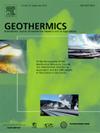混合机制控制着中低焓地热区的水文地球化学组成
IF 3.5
2区 工程技术
Q3 ENERGY & FUELS
引用次数: 0
摘要
中国拥有丰富的中、低焓地热资源,主要分布在沉积盆地、沿海地区和山地断裂带。武公山地区是一个典型的中低焓地热田,近年来因其广泛的地热资源而备受关注。前人对武公山地区热液系统的水化学演化和形成机制进行了研究,发现了明显的混合过程。然而,这些混合作用对该区地热储层温度和水化学演化的影响尚未深入研究,限制了对该区热液系统的认识。本研究采用综合多分量地热(IMG)方法估算储层温度,有效地减轻了混合过程造成的误差。结果表明,武公山地区地热流体主要由26 ~ 82%的原始地热流体和18 ~ 74%的冷水组成。古大气降水是地热流体的主要来源,随着浅层冷水的加入,地热流体与浅层冷水的同位素特征越来越相似。此外,浅层冷水的涌入,携带了土壤中的CO2和O2,增强了研究区硅酸盐矿物的风化作用和硫化物矿物的氧化作用,改变了地热流体中HCO3 -、SO42 -和微量元素的浓度。断裂带对深部地热流体的循环和上行运移起着至关重要的促进作用,混合过程是驱动地热水地球化学变化的关键机制。本文章由计算机程序翻译,如有差异,请以英文原文为准。
Mixing mechanisms control the hydrogeochemical composition in medium-low enthalpy geothermal areas
China has abundant medium-low enthalpy geothermal resources, primarily distributed across sedimentary basins, coastal regions, and mountainous fault zones. The Wugongshan area is a typical medium-low enthalpy geothermal field that has attracted considerable attention recently due to its widespread geothermal resources. Previous studies have investigated the hydrochemical evolution and formation mechanisms of hydrothermal systems in the Wugongshan area, and significant mixing processes have been found. However, the effects of these mixing processes on the geothermal reservoir temperature and the hydrochemical evolution in the area have not yet been investigated in detail, which has limited understanding of the hydrothermal system in this area. The integrated multicomponent geothermometry (IMG) method was employed in the present study to estimate the reservoir temperatures, effectively mitigating inaccuracies caused by mixing processes. The results showed that the geothermal fluid in the Wugongshan area comprised 26–82 % initial geothermal fluid and 18–74 % cold water. Ancient meteoric water was the principal source of geothermal fluids, and the isotopic signatures of geothermal fluids and shallow cold water became increasingly similar as more shallow cold water was mixed in. Additionally, the influx of shallow cold water, which carried CO2 and O2 from the soil, enhanced the weathering of silicate minerals and the oxidation of sulfide minerals in the research area, altering the concentrations of HCO3–, SO42– and trace element concentrations in the geothermal fluid. The results also revealed that the fault zones play a crucial role in facilitating the circulation and upward migration of deep geothermal fluids, and the mixing processes are a key mechanism driving geochemical changes in the geothermal waters.
求助全文
通过发布文献求助,成功后即可免费获取论文全文。
去求助
来源期刊

Geothermics
工程技术-地球科学综合
CiteScore
7.70
自引率
15.40%
发文量
237
审稿时长
4.5 months
期刊介绍:
Geothermics is an international journal devoted to the research and development of geothermal energy. The International Board of Editors of Geothermics, which comprises specialists in the various aspects of geothermal resources, exploration and development, guarantees the balanced, comprehensive view of scientific and technological developments in this promising energy field.
It promulgates the state of the art and science of geothermal energy, its exploration and exploitation through a regular exchange of information from all parts of the world. The journal publishes articles dealing with the theory, exploration techniques and all aspects of the utilization of geothermal resources. Geothermics serves as the scientific house, or exchange medium, through which the growing community of geothermal specialists can provide and receive information.
 求助内容:
求助内容: 应助结果提醒方式:
应助结果提醒方式:


